CDP Data Center Console allows you to monitor parameters of Disk Safes on multiple CDP Servers at once. You can do so from the "Disk Safes" screen.
Follow the instructions below to access the "Disk Safes" screen.
1. Select "Disk Safes" from the Main Menu.
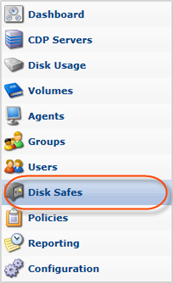
You will enter the "Disk Safes" screen.
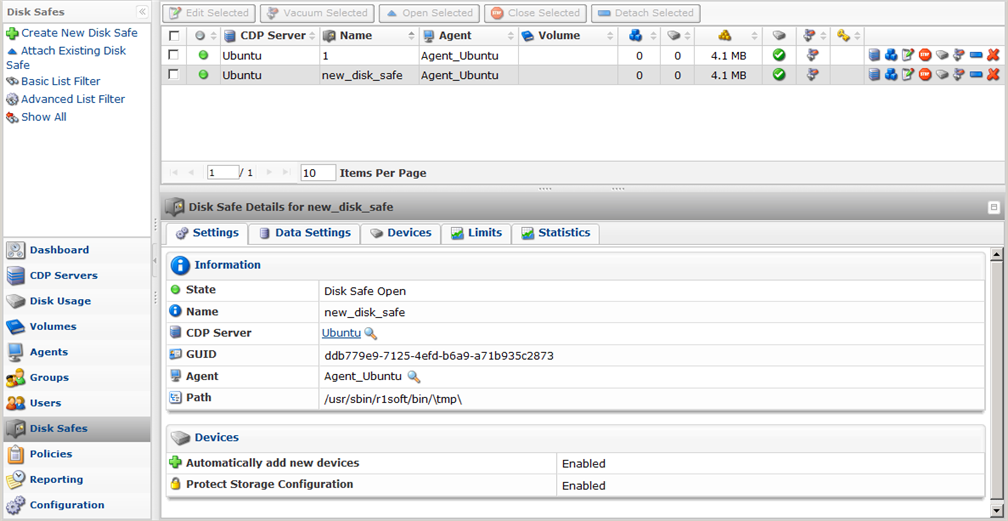
The "Disk Safes" List
The list of all Disk Safes is displayed with the following columns:
- Enabled - Graphically indicates the Disk Safe state. If the icon is green, then the Disk Safe is opened. The red icon is used for closed Disk Safes.
- CDP Server - The name of the CDP Server to which the current Disk Safe belongs.

Note
The server name displays in the form of a link. You can click the link for quick access to the CDP Server.

- Agent - Displays the name of the Agent to which the Disk Safe is assigned.
- Volume - Displays the name of the Volume to which the Disk Safe is assigned.
- Name - Displays the name of the Disk Safe.
- Path - This column displays the path to the folder where the Disk Safe is physically located.
- Recovery Points - Displays the number of Recovery Points in the Disk Safe.
- Devices - Displays the number of Devices assigned to the Disk Safe.
- On Disk Size - Displays the disk space occupied by the Disk Safe.
- All Devices - Indicates if all Host's Devices are assigned to the Disk Safe. If the "All Devices" option was selected for the Disk Safe, then there is a green icon in this column. Otherwise, there will be no icon.
- Compression - Displays the compression level set for the Disk Safe. Possible values: "ZLib Low," "ZLib Medium," "ZLib High," "NONE," "QuickLZ."
- Actions - This column contains the list of actions that can be performed over the Disk Safe. See the description below.
Disk Safe Actions
The CDP Servers list contains the "Actions" pane.

The following Actions are available:
| Icon | Action | Description |
|---|---|---|
| |
Open CDP Server to view Disk Safes | Click this icon to to "drill down" to the specified CDP's "Disk Safes" screen. |
 |
View Recovery Points | Click this icon to change server name and/or description. |
 |
Edit | Click this icon to edit Disk Safe properties. See Editing Disk Safes in Data Center Console. |
 |
Close | Click this icon to close the opened Disk Safe. See Closing Disk Safes in Data Center Console. |
 |
Open | Click this icon to open the closed Disk Safe. See Attaching Disk Safes in Data Center Console. |
 |
Devices | Click this icon to view Devices. |
 |
Vacuum | Click this icon to vacuum selected Disk Safe. See Vacuuming Disk Safes in Data Center Console. |
 |
Detach | Click this icon to detach the Disk Safe from the Console. Detaching Disk Safes in Data Center Console. |
 |
Delete | Click this icon to delete the Disk Safe from the Console. |
You can perform some of the actions on several Disk Safes at once by selecting them from the list using checkboxes and clicking the corresponding button at the top.
- Edit Selected
- Vacuum Selected
- Open Selected
- Close Selected
- Detach Selected
See the descriptions of these actions in the table above.
Filtering the "Disk Safes" List
Basic List Filter
You can use a Basic List Filter to sort the "Disk Safes" list. Click on the "Basic List Filter" button to access the filtering options.

1. Select the necessary options to filter.

- State- Allows you to sort by the Disk Safe state (opened or closed).
- Name - Allows you to sort by the Disk Safe name.
- CDP Server Name - Allows you to sort by CDP Server name.
2. Select the type of search from the drop-down menu (Starts With/Contains/Ends With) and enter the Name//Server name to the field. Select whether to display "Opened" or "Closed" Disk Safes.
For example:

3. Click on the "Filter" button.

If you want to discard filtering options and view the whole list, click "Show all."
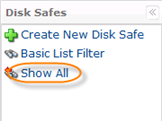
Advanced List Filter
The Advanced List Filter allows you to reduce the number of Disk Safes in the list on the basis of all possible filter options.
Follow the instructions below to apply the Advanced Filter to the "Disk Safes" list.
1. Click on "Advanced List Filter" located in the Disk Safe sub-menu.

2. The "Advanced List Filter" window will open.
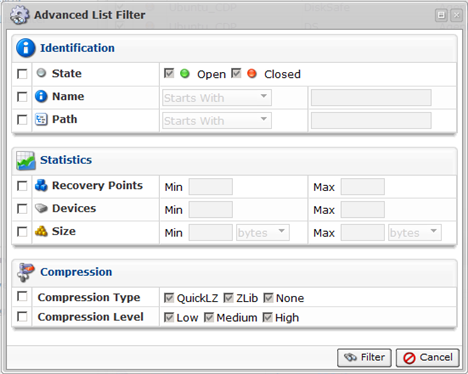
This window has several blocks with filter options.
| Tip You can hide/open the filter options for every block by clicking on the header of the corresponding block. |
3. Set one or several filter options to search the required Disk Safes.
Identification
- State- Allows you to sort by the Disk Safe state (opened or closed).
- Name - Allows you to sort by the Disk Safe name.
- Path - Allows you to sort by the Disk Safe path.
Statistics
Provides the following filter options:
- Recovery Points - Select this checkbox to filter the list on the basis of the number of the Recovery Points.
- Min - Recovery Points more than or equal to this number.
- Max - Recovery Points less than or equal to this number.
- Devices - Select this checkbox to filter the list on the basis of the number of the Devices for the Disk Safe.
- Min - Device quantity more than or equal to this number.
- Max - Devices quantity less than or equal to this number.
- Size - Select this check-box to filter the list on the basis of the number of the Devices for the Disk Safe.
- Min - Disk Safe size more than or equal to this number. You can enter a number in Bytes, KB, MB, GB, TB or PB using the corresponding drop-down menu.
- Max - Disk Safe size less than or equal to this number. You can enter a number in Bytes, KB, MB, GB, TB or PB using the corresponding drop-down menu.
Compression
Provides the following filter options:
- Compression Type - Select this checkbox to filter the list on the basis of the Compression Type.
- QuickLZ - To search for the Disk Safes where Compression Type is "QuickLZ."
- Zlib - To search for the Disk Safes where Compression Type is "Zlib."
- None - To search for the Disk Safes where Compression is not used.

Tip
By default, the "None" and "Zlib" checkboxes are checked and all Disk Safes are displayed.
- Compression Level - Select this checkbox to filter the list on the basis of the Compression Level.
- Low - To search for the Disk Safes where Compression Level is "Low."
- Medium - To search for the Disk Safes where Compression Level is "Medium."
- High - To search for the Disk Safes where Compression Level is "High."

Tip
By default, the "Low," "Medium" and "High" checkboxes are checked and all Disk Safes are displayed.
4. Click on "Filter" to apply the filter to the "Disk Safes" list.
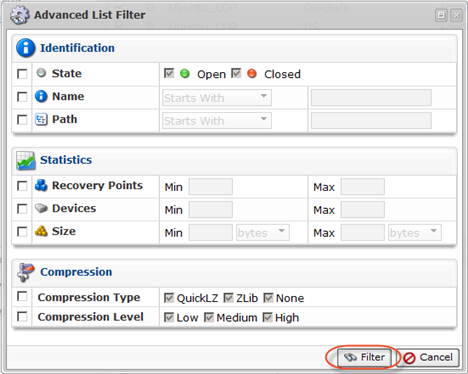
| Tip Click the "Show all" link to see the whole list of Disk Safes.  |
Disk Safe Details Pane
This pane provides detailed information about the Disk Safe selected in the list. Most of the presented data is the same as the data shown in the "Disk Safes" list columns (See above). The following information is available:
| Tip You can collapse/expand the details of a block by clicking on the header of the corresponding block. |
Settings Tab
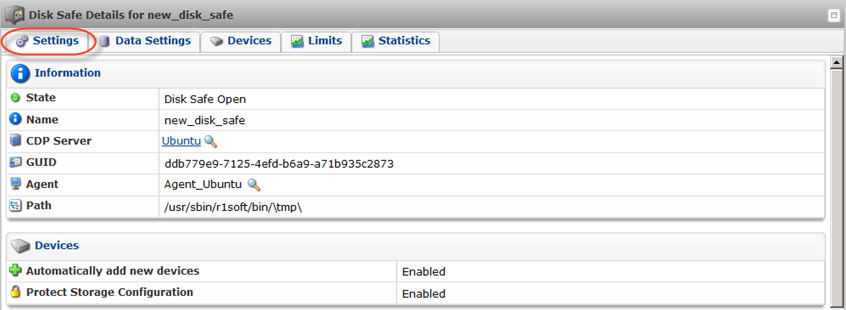
Information
- State - Displays if the Disk Safe is open or closed
- Name - The name of the Disk Safe is shown. The name is defined during Disk Safe creation. It can be edited later. It is used to identify the Disk Safe in the list.
- CDP Server - The name of the CDP Server is shown.
- GUID - Globally Unique Identifier generated by the system.
- Agent - The name of the Agent is shown.
- Volume - The Volume that includes the Disk Safe.
- Path - Path where the Disk Safe is physically located. For example, C:\Disk_Safe.
Devices
- Automatically add new devices - This option will automatically add all available devices to the Disk Safe. Uncheck the checkbox to select the devices you want to add to the Disk Safe.
- Protect Storage Configuration - This option allows to back up partition tables.
- Backup Windows System Reserved and Unmounted Partitions - This option allows to back up hidden Windows system partition.
- If you click on the
 icon near the CDP Server name, you will access the server details window.
icon near the CDP Server name, you will access the server details window.
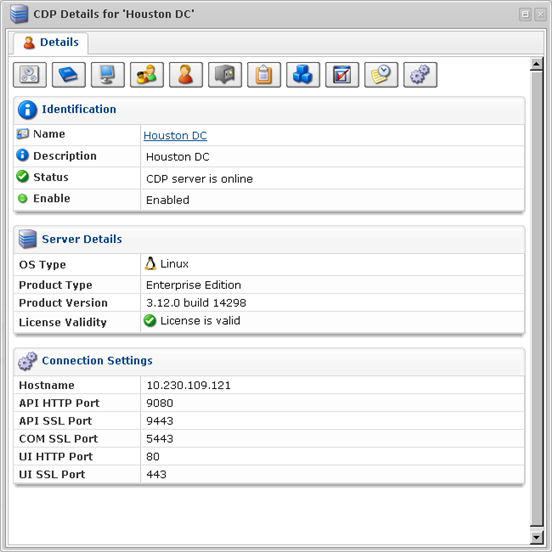
For more information about server details, see Accessing CDP Servers in Data Center Console.
- If you click on the
 icon near the Agent name, you will access the Agents Details window.
icon near the Agent name, you will access the Agents Details window.
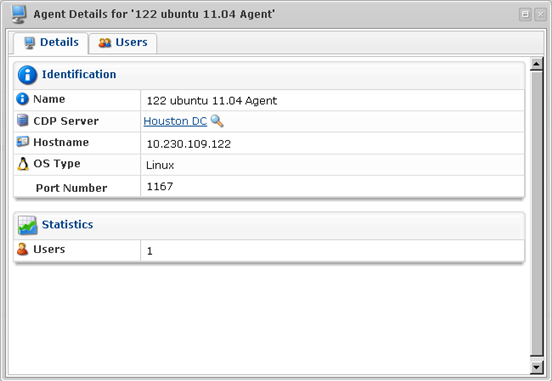
For more information about Agent details, see Monitoring Agents in Data Center Console.
- If you click on the
 icon near the Volume name, you will access the Volumes details window.
icon near the Volume name, you will access the Volumes details window.
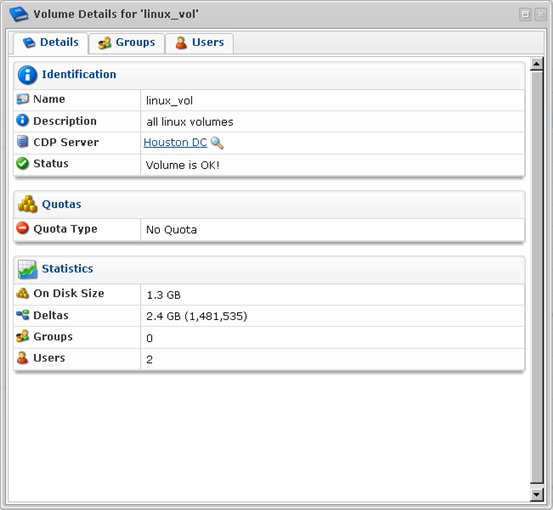
For more information about Volume details, see Monitoring Volumes in Data Center Console.
Data Settings Tab

Compression
- Compression Type - The compression level set for the Disk Safe. Possible values: "ZLib Low," "ZLib Medium," "ZLib High," "QuickLZ" and "NONE."
Encryption
- Encryption Type - You can assign an AES 256-Bit encryption to the Disk Safe. In that case, you will be asked to create a password. If you choose to encrypt a Disk Safe, the password must be supplied to: browse files, browse Control Panel users, browse databases and initiate BMR.
Devices Tab

Assigned Devices and information about them. Read more in Devices.
Limits Tab
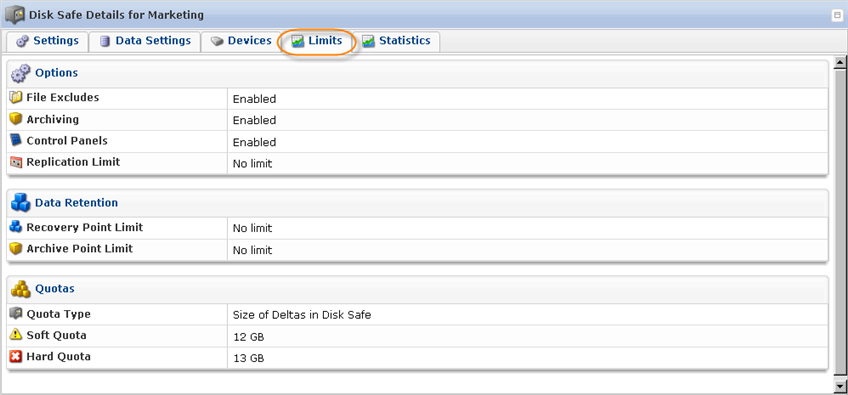
Options
- File Excludes - Indicates whether File Excludes and Advanced Excludes are allowed on the Disk Safe.
- Archiving - Indicates whether the Archiving is allowed on the Disk Safe.
- Control Panels - Indicates whether Control Panels are enabled or disabled on the Disk Safe.
- Replication Limit - Shows the Replication Limit.
Data Retention
- Recovery Point Limit - The maximum number of Recovery Points stored in the Disk Safe.
- Archive Point Limit - The maximum number of Archive Points stored in the Disk Safe.
Quotas
- Quota Type - The type of quota assigned to the Disk Safe. Quotas are set to limit the disk usage of the Disk Safe. The limit is set on the basis of space occupied by Disk Safes or size of deltas.
- Soft Quota - The value in bytes or in deltas. Soft Quota is a warning level that informs users that they are close to reaching their effective limit.
- Hard Quota - The value in bytes or in deltas. Hard Quota allows resources to be occupied by data. If the Hard Quota is reached, then the system forbids generation of new Recovery Points. The replication is interrupted and failed.
Statistics Tab

- Devices - The number of assigned Devices.
- Recovery Points - The number of Recovery Points in the Disk Safe.
- Archive Points - The number of Archive Points in the Disk Safe.
- On Disk Size - The disk space occupied by the Disk Safe.
- Deltas - Deltas are the data that has changed since the last backup run.
- Pages
- Free Pages
